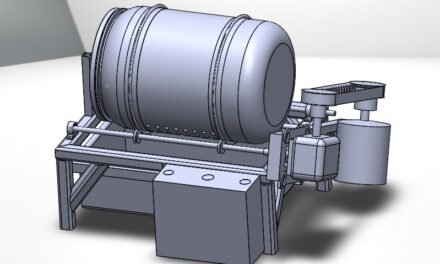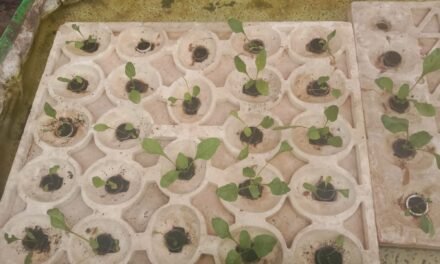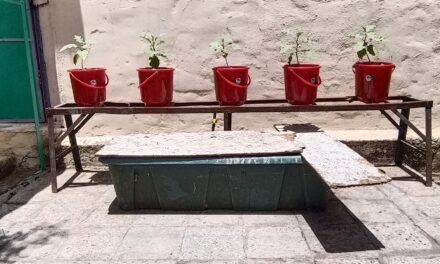For making flocponics project I taken reference of some research papers and books given in below links
https://onlinelibrary.wiley.com/doi/full/10.1111/raq.12617
Introduction
FLOCponics is an alternative type of aquaponics that integrates biofloc technology (BFT) with soilless plant production. FLOCponics is defined as the integration of biofloc-based aquaculture with hydroponics. Aquaponics and biofloc-based aquaculture are considered environment-friendly approaches to food production. Both are intensive aquaculture systems with a strong focus on nutrient recycling and water saving. FLOCponics shares these characteristics. By adopting the principles of aquaponics and bioflocs, FLOCponics can become an additional means to reduce the challenges of the global sustainable food supply. Recently, the term ‘FLOCponics’ was proposed by Pino et al. to identify and unify the systems that have been called ‘BFT+hydroponics’, ‘BFT+aquaponics’ or ‘BFT+plant production’

BIOFLOC TECHNOLOGY
Biofloc Technology (BFT) was developed in the 1970s, by the French Research Institute for Exploitation of the Sea (IFREMER). Biofloc-based culture is characterized by the presence of specific microbial communities, which enable the intensive and biosafe culture of aquatic organisms. The growth of heterotrophic bacteria is stimulated by the manipulation of the carbon: nitrogen (C:N) ratio, normally ranging from 10 to 20:1, with constant water movement and aeration and minimal water exchanges. In addition to heterotrophic bacteria, chemoautotrophic bacteria and planktonic organisms, mainly microalgae, copepods, Cladocera, protozoa and rotifers, are also frequently reported in biofloc cultures. The predominance of each group of microorganisms will depend on the target shrimp/fish species, the productive management, and the inputs used. Such predominance will define the BFT trophic level, usually categorized as photoautotrophic (algae-based system), chemoautotrophic (based on nitrifying bacteria), heterotrophic (based on heterotrophic bacteria), or mixotrophic systems.
AQUAPONICS
In aquaponics systems, aquaculture effluents are transformed by nitrifying bacteria into bioavailable nutrients for plants, supporting almost full feed utilization and plant growth. In aquaponics, nutrients are recycled and low volumes of water are used, which reduces the negative environmental impacts usually associated with low efficiency in the use of natural resources in conventional food production.
To make Agri-aquaculture integration viable, a basic layout including some indispensable components is required. An aquaponics system basically consists of aquatic organism tanks and filters (mechanical and biological), which make up the recirculating aquaculture system, connected to hydroponic beds.
Need of this project
- overview of the FLOCponics system’s designs and performance, discuss their sustainability of plants.
- Data sources include containing the keywords bio flocs and hydroponics, aquaponics and/or plant production.
- The global demand for safe and healthy food has increased significantly in the last few years due to world population growth, projected to reach 9.7 billion people in 2050.
- Providing them with healthy food is a major global challenge, especially in the current scenario of natural resource scarcity
Objectives:
- To study about biofloc and check feasibility of flocponics in hydroponics system.
- To collect floc water from radial flow filter and activate hydroponics (NFT) system in vigyan ashram
Flocponics System setup
In Flocponics systems Different types of hydroponics subsystems are employed, in which the Nutrient Film Technique (NFT) and Deep-Water Culture (DWC) were mostly used. NFT comprises shallow channels where the plants are allocated. A thin layer of nutrient solution flows through these channels to partially irrigate the roots of the plants. In DWC plants are produced in floating supports on tanks filled with nutrient solution. We used NFT system for flocponics. In BFT production, the use of simple settling tanks is often needed to control the solids concentration in the fish/shrimp tanks. A high concentration of solids can negatively impact the operation of the system since it can result in higher oxygen demand. Therefore, in this project need filter which separates solid particles and water.

Nutrient film technique ( NFT) system:
The full form NFT is Nutrient Film Technique. NFT is an active & recovery system. It’s a very common hydroponic system which is used in home gardening and commercial hydroponics project. The actual nutrient solutions are usually pumped into the growing tray (normally by tube) and flow across the roots of the plants, and after that nutrients drain back to the reservoir. There is normally no growing media used other than air flow, which saves the cost of replacing your growing media after every crop.
How it NFT works:
A pump constantly forces the rich nutrient solution right onto the grow tray, flow over plants roots. Then simply it drains back into the reservoir through the slightly downwards channel. No timer required for a submersible pump.

Advantages of NFT :
Little or none growing media used.
Save water and nutrient solution by Recirculating
Easy System Maintenance
Disadvantages:
Susceptible to power outages and pump failure
Not suitable for heavy and large plants
6/09/2022 to 7/09/2022
Discussion:
Discussed about radial flow filter with Ranjit sir. And also, sir said that how to make Radial flow filter, collect required material for that Discussed about radial flow filter with Ranjit sir. And also, sir said that how to make Radial flow filter, collect required material for that Discussed about radial flow filter with Ranjit sir. And also, sir said that how to make Radial flow filter. As per discussion I collected required material for making radial flow filter from scrab and purchased.
8/09/2022 to 12/09/2022
I collected some information about radial Flow filter. I read and take information in research paper. Also take reference for making filter https://www.researchgate.net/publication/312389753_Settler_evaluation_radial_flow_vs_tangential_flow
DIY Radial flow filter
Radial Flow filters are a type of filter that removes all the gunk and fish poop that occurs in a recirculated aquaponics system.
The radial flow separator, also called the radial flow filter or radial flow settler, is the most used filter in aquaponics.
The water (containing particulate matter) flows from the fish tank into the center of the radial flow separator where it is forced downwards. The water velocity drops abruptly at the change of direction and the solids continue downwards and settle out while the clear water exits the separator via the overflow weir.

I have taken reference for making radial flow filter following figure for making radial flow filter. Then I collect Martials for making radial flow filter

13/09/2022
Materials:
| No | Materials | Quantity | Availability |
| Mechanical | |||
| 1 | 63 mm PVC Pipe | 2 feet | Market |
| 2 | 63 mm Elbow | 3 | Market |
| 3 | Drum | 1 | Available |
| 4 | 20 L plastic jar | 1 | Available |
| 5 | PVC Solution (100 ml) | 1 | Market |
| 6 | PVC FTA (50 mm) | 1 | Market |
| 7 | PVC FTA (63 mm) | 1 | Market |
| 8 | PVC Reducer (75×63) | 1 | Available |
| 9 | UPVC tank nipple (50 mm) | 2 | Market |
| 10 | UPVC tank nipple (63 mm) | 1 | Market |
| 11 | Valve (50 mm) | 2 | Available |
| 12 | Rod pieces | 2 (30 cm /rod) | Available |
Bill of material
Process of making radial flow filter
- Firstly, we marked three holes on drum for slush removal, inlet and outlet by using marker
- Then made holed by using heat and PVC solution.
- Cut the pipes as per requirement
- Connected 63 mm pipe from bio floc outlet to inlet of radial flow filter
- Made hole for plastic jar and joined PVC pipe with 63 mm elbow
- Connected elbow inside the 20 L plastic jar.
- Joined UPVC nipple for outlets one is collected filter water and another one is removed solid particles.
- Connected valve to outlets which help to close and open
- Attached two rods on the top of drum which supported for 20 L plastic jar inside the drum.
- Connected inlet to biofloc tank
- It separates water and solid particles
- We will collect floc water after settled water from center outlet because bottom of drum me made another outlet for removing solid particles
- Removed solid particles at bottom of drum which settled down water from bio floc.
- While making radial flow filter @Sonawanevishal, @Taralesamarth @goutam and @Hrutik helped me



Flow Chart of Radial flow filter

13/09/2022
Installed radial flow filter and did trail.

17/09/2022 21/09/2022
Collected water from radial flow filter
| No | Date | Collected floc water from radial flow filter |
| 1 | 17/9/2022 | 45 L |
| 2 | 18/9/2022 | 60 L |
| 3 | 19/9/2022 | 80 L |
| 4 | 20/9/2022 | 25 L |
| 5 | 21/9/2022 | 15 L |
22/09/20222
Selection of plants for flocponics and hydroponics
- Spinach
- Coriander
- Fenugreek
- Meant
We sown seeds lettuce, coriander and fenugreek in Seedling trays. Sprayed water on Seedling trays. While sowing seeds @Taralesamarth and @Sawantmrunal

23/09/2022 to 30/09/2022
Sprayed water on Seedling trays
| Date | Water sprayed on seedling tray |
| 23/9/2022 | 2 L |
| 24/9/2022 | 2 L |
| 25/9/2022 | 2 L |
| 26/9/2022 | 2 L |
| 27/9/2022 | 2 L |
| 28/9/2022 | 2 L |
| 29/9/2022 | 2 L |
| 30/9/2022 | 2 L |

1/10/2022 to 7/10/2022
Sprayed water to seedling tray After sowing seeds and few 15 days later seeds are germinated

8/10/2022
After 15 days transplanting seedling trays to net cup and installed NFT system.
Did plantation same day and same plants in hydroponics
Did plantation in first row lettuce, second row coriander , third row fenugreek and final row meant


Collected floc water which collect from radial flow filter and filled in drum for flocponics and another drum filled with water
Calculations:
1.Volume of reservoir for flocponics
V = l× b ×h
= 92 cm × 115 cm × 74.4 cm
= 787152 cm3
converting cm3 to Liter
787152/1000
V = 787.152 L
2. volume of reservoir for hydroponics
V = l× b ×h
= 94 cm× 94 cm× 45cm
= 397620 cm3
converting cm3 to Liter
= 397620/1000
V = 397.620L
11/10/2022 to 16/10/2022
After transferring plants in NFT systems andWater circulates continuous in NFT system.
- Checked TD, EC and pH of both NFT system of flocponics and hydroponics.
- Collected water from radial flow filter and transfer into reservoir
| No | Date | floc water |
| 1 | 11/10/2022 | 21 L |
| 2 | 12/10/2022 | 45 L |
| 3 | 13/10/2022 | 35 L |
| 4 | 14/10/2022 | 20 L |
17/10/2022
Discussion
Discussed with sonal mam about leaves and flocponics. Discussed with problems of flocponics.
Observed Problems
- Leaves turns yellow colour both systems due to over irrigation or magnesium or nitrogen deficiency.
- In flocoponics system plants are burned and roots are damaged due to temperature and algae
- Fenugreek and coriander plants are totally damaged

Solution
After discussion found some solution that are following
- Cover black paper or green setnet on reservoir of flocponics which will avoid algae.
- To give chemical nutrient to Flocponics
28/10/2022
Discussion
Discussed with prasad sir about flocponics and NFT systems their problems. And sir said that find causes and effect of that and make fishbone diagram/cause and effect diagram
29/10/2022
Made fishbone diagram

Discussion
Discussed with dixit sir about flocponics. We discussed about problem of flocponics and damaged plants. Sir said some suggestion that change another media and cover black paper on reservoir. Sir said that Make replantation of lettuce, meant and Alu in NFT system for flocponics system.
We discussed to make second trail by replantation.
Observations:
First trail
| No | Plants | periods (Days) | Flocponics (NFT) | Hydroponics (NFT) |
| 1) | Spinach | 10 days | Spinach plants are sustained | Spinach plants are grown more than flocponics system. and sustained |
| 2) | Coriander | 10 days | Coriander plants are damaged due to algae and Temperature | Coriander plants are damaged due to algae and Temperature |
| 3) | Fenugreek | 10 days | Fenugreek are not grown in this system. | Fenugreek are not grown in this system |
| 4) | Meant | 8 days | Meant grows well and sustained. | Meant grows well and sustained |

We stopped first trail due to fishes are died in biofloc tank due to we didn’t collect floc water. Then we decided that make floc by using fishes in tank/ reservoir and without using radial flow filter. We decided that make second trail of floc
31/10/2022
SECOND TRIAL
As per discussion sown lettuce seeds in seedling trays. Sown for replantation trail second.
1/11/2022 to 10/11/2022
Sprayed water on seedling trays.
| Date | Water Sprayed on seedling tray ( L) |
| 1/11/2022 | 1 |
| 2/11/2022 | 1 |
| 3/11/2022 | 1 |
| 4/11/2022 | 1 |
| 5/11/2022 | 1 |
| 6/11/2022 | 1 |
| 7/11/2022 | 1 |
| 8/11/2022 | 1 |
| 9/11/2022 | 1 |
| 10/11/2022 | 1 |
Discussion:
Discussed with Ranjit sir and sonal mam about flocponics. We decided to make second trail on flocponics.
Process:
- In second trail we decided that make culture and fishes (tilapia) add directly in reservoir/tank/drum. Make floc in drum. Directly to use in NFT system without filter. Culture helps to build floc in fish tank.
- As per our discussion Firstly we made culture with the help of sonal mam. Cleaned drum and filled water
- After 5 days of making culture transfer into drum/Reservoir
- .We used floc without filter in NFT system hydroponics in second trail.
Process of making culture for Flocponics:


11/11/2022
Added culture into drum. Again transferred 1.2 kg fishes (Tilapia)into drum or reservoir to make floc . While adding culture into drum @rohan helped me. We provided bubbler to Fishes.
Note: When you add culture in water kept 5 days . After 5 days you can add fishes in tank

12/11/2022
- Fishes are died in that tank . then we check water pH, EC and TDS
PH – 7.74
TDS – 336
EC – 665
2. Fishes died due to following reasons
- Poor oxygen supply
- Infection
- Unsuitable Environment
- Less DO
fishes are dead due to we didn’t make floc water that’s why we didn’t trail second on plants in NFT system.
Result:
- It is possible to do flocponics by using hydroponic system ( NFT)
- Plants are ( Palak and pudina ) sustained in Flocponics.
Conclusion:
- While transplanting plants into NFT system some plants could not sustained may be due to following reasons:
- Algae in floc water and cocopeat media
- High temperature in the surrounding/ polyhouse
- Poor nutrients supply
- High pH level and low TDS level
- While making flocponics floc was not available in biofloc due to death of fish
- In first trail spinach and mint plants could be sustained and Fenugreek and coriander plants could not. We stopped first trail as we could not collected floc water from radial flow filter as fishes are died in biofloc tank.
- In Second trail we make floc direct water tank without filter. When we directly tried to make floc in tank fishes died due to which second trail failed.
Suggestion:
- Maintain biofloc properly
- Use filter water for flocponics which is separated radial flow filter.
- Avoid algae in floc water and used in NFT or DWC system.
- Provide oxygen supply in biofloc
- Avoid second trail in this project





